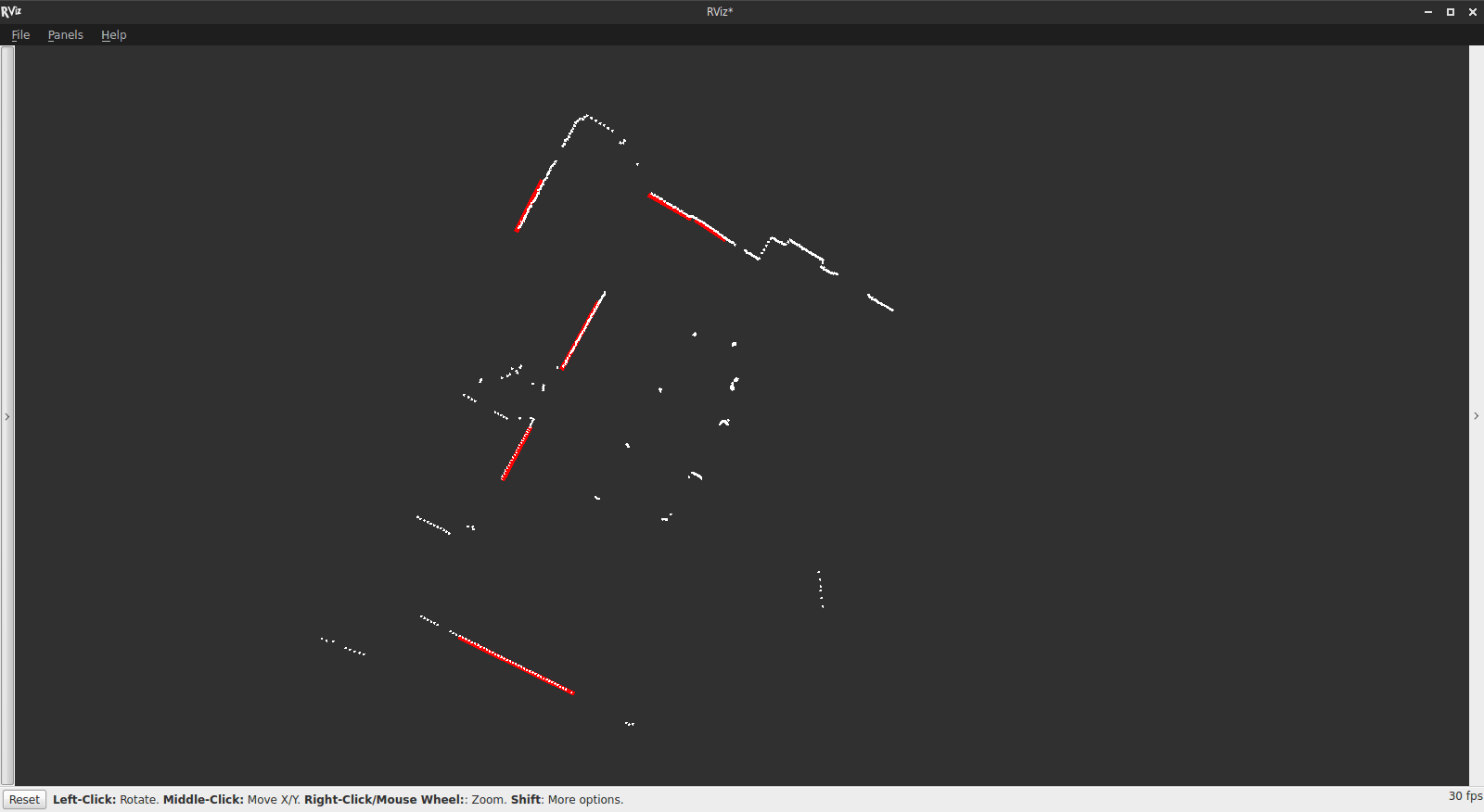kam3k / Laser_line_extraction
Labels
Projects that are alternatives of or similar to Laser line extraction
Laser Line Extraction
Laser Line Extraction is a Robot Operating System (ROS) package that extracts line segments form LaserScan messages. Created by Marc Gallant, originally for use in the Mining Systems Laboratory. Here is what the Laser Line Extraction package looks like in action:
In the above image, the white dots are points in a LaserScan message, and the red lines are what is extracted by Laser Line Extraction. This data was collected by driving a robot through Beamish-Munro Hall at Queen's University. A SICK LMS111 laser scanner was mounted to the robot. The extraction algorithm is very configurable; the above image used the parameters configured in the example.launch launch file.
After applying some filters to remove outlying points, Laser Line Extraction implements a split-and-merge algorithm to determine which points belong to lines. Next, it implements the weighted line fitting algorithm by Pfister et al. [1] to find the best fit lines and their respective covariance matrices.
Usage
I recommend making a copy of example.launch in the launch directory and configuring the parameters until you reach a desirable outcome. The parameters in example.launch are a good starting point. Then simply use roslaunch, e.g.,
roslaunch laser_line_extraction example.launch
Messages
Laser Line Extraction has two messages types:
LineSegment.msg
float32 radius
float32 angle
float32[4] covariance
float32[2] start
float32[2] end
radius (m) and angle (rad) are the polar parameterization of the line segment. covariance is the 2x2 covariance matrix of radius and angle (listed in row-major order). Finally start and end are the (x, y) coordinates of the start and end of the line segment.
LineSegmentList.msg
Header header
LineSegment[] line_segments
An array of LineSegment.msg with a header.
Topics
Laser Line Extraction subscribes to a single topic and publishes one or two topics.
Subscribed topics
-
/scan(sensor_msgs/LaserScan)- The name of this topic can be configured (see Parameters).
Published topics
-
/line_segments(laser_line_extraction/LineSegmentList)- A list of line segments extracted from a laser scan.
-
/line_markers(visualization_msgs/Marker)- (optional) Markers so that the extracted lines can be visualized in rviz (see above image). Can be toggled (see Parameters).
Parameters
The parameters are listed in alphabetical order.
-
bearing_std_dev(default: 0.001)- The standard deviation of bearing uncertainty in the laser scans (rad).
-
frame_id(default: "laser")- The frame in which the line segments are published.
-
least_sq_angle_thresh(default: 0.0001)- Change in angle (rad) threshold to stop iterating least squares (
least_sq_radius_threshmust also be met).
- Change in angle (rad) threshold to stop iterating least squares (
-
least_sq_radius_thresh(default: 0.0001)- Change in radius (m) threshold to stop iterating least squares (
least_sq_angle_threshmust also be met).
- Change in radius (m) threshold to stop iterating least squares (
-
max_line_gap(default: 0.4)- The maximum distance between two points in the same line (m).
-
min_line_length(default: 0.5)- Lines shorter than this are not published (m).
-
min_line_points(default: 9)- Lines with fewer points than this are not published.
-
min_range(default: 0.4)- Points closer than this are ignored (m).
-
max_range(default: 10000.0)- Points farther than this are ignored (m).
-
min_split_dist(default: 0.05)- When performing "split" step of split and merge, a split between two points results when the two points are at least this far apart (m).
-
outlier_dist(default: 0.05)- Points who are at least this distance from all their neighbours are considered outliers (m).
-
publish_markers(default: false)- Whether or not markers are published.
-
range_std_dev(default: 0.02)- The standard deviation of range uncertainty in the laser scans (m).
-
scan_topic(default: "scan")- The LaserScan topic.
References
[1] S. T. Pfister, S. I. Roumeliotis, and J. W. Burdick, "Weighted line fitting algorithms for mobile robot map building and efficient data representation" in Proc. IEEE Intl. Conf. on Robotics and Automation (ICRA), Taipei, Taiwan, 14-19 Sept., 2003.

